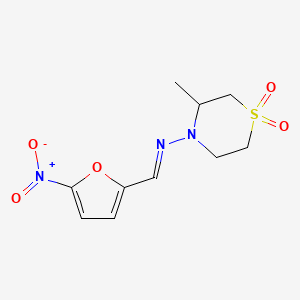CASRN: 23256-30-6

Drug Levels and Effects
Summary of Use during Lactation
Limited information indicates that maternal doses of nifurtimox up to 15 mg/kg daily produce do not cause any adverse serious effects in breastfed infants. Breastmilk levels and a computer simulation found that the dose that an exclusively breastfed infant would receive through breastmilk would be much less than the dose given to treat Chagas disease in newborn infants. Other authors consider that breastfeeding is not contraindicated during the use of nifurtimox.[1,2]
Drug Levels
Maternal Levels. A computer simulation using pharmacokinetic data from adults and assuming milk-plasma ratios of 1 resulted in an estimated median infant dose of 0.19% of the maternal weight-adjusted dosage. Assuming milk-plasma ratios of 6 resulted in an estimated maximum infant dose of 3.1% of the maternal weight-adjusted dosage.[3]
Four women with Chagas disease were treated with nifurtimox 10 to 15 mg/kg daily in 3 divided doses provided breastmilk samples for analysis after 4 to 10 days of therapy. The timing of the sample with respect to doses was not reported. Breastmilk concentrations of nifurtimox ranged from nonquantifiable (<0.55 mg/L) to 8.2 mg/L.[4]
Ten women were receiving a median dose of nifurtimox of 9.75 mg/kg daily donated 1 or 2 milk samples at various times after a dose at steady state. The median nifurtimox concentration in milk was 2.15 mg/L (interquartile range 1.32 to 4.55 mg/L). The authors estimated that infants would receive a median daily dosage of 0.5 mg/kg, which is equal to a median weight-adjusted maternal dose of 6.7% (interquartile range 2.35 to 7.19%).[5]
Infant Levels. Relevant published information was not found as of the revision date.
Effects in Breastfed Infants
A cohort of 33 infants who were breastfed (extent not stated) by hospitalized mothers taking nifurtimox was followed in the Democratic Republic of the Congo. Thirty mothers took a full course of 30 doses of oral nifurtimox 15 mg/kg daily and all received 14 doses of intravenous eflornithine 400 mg/kg daily for 7 days for human African trypanosomiasis. (sleeping sickness). Nursing mothers also took a median of 4 other concomitant medications, including amoxicillin, ciprofloxacin, metronidazole, trimethoprim-sulfamethoxazole, aspirin, and diclofenac (1 patient each); hydrocortisone, promethazine and quinine (2 patients each); levamisole (6 patients); sulfadoxine-pyrimethamine (8 patients); dipyrone (13 patients); acetaminophen (16 patients); and mebendazole (17 patients). No serious adverse events were reported in any of the breastfed infants.[6-8]
Effects on Lactation and Breastmilk
Relevant published information was not found as of the revision date.
References
- 1.
- Sankale M, Brun A. Les medicaments des parasitoses tropicales au cours de la grossesse et de l'allaitement. (2 parts). Le Concours Medical 1991;14:2335-9; 248-51.
- 2.
- Barennes H, Choonara I. Breast feeding and drug therapy in neglected diseases. Arch Dis Child. 2010;95:222–3. [PubMed: 20308339]
- 3.
- García-Bournissen F, Altcheh J, Panchaud A, et al. Is use of nifurtimox for the treatment of Chagas disease compatible with breastfeeding? A population pharmacokinetics analysis. Arch Dis Child. 2010;95:224–8. [PubMed: 19948512]
- 4.
- Padró JM, Pellegrino Vidal RB, Echevarria RN, et al. Development of an ionic-liquid-based dispersive liquid-liquid microextraction method for the determination of antichagasic drugs in human breast milk: Optimization by central composite design. J Sep Sci. 2015;38:1591–600. [PubMed: 25711461]
- 5.
- Moroni S, Marson ME, Moscatelli G, et al. Negligible exposure to nifurtimox through breast milk during maternal treatment for Chagas Disease. PLoS Negl Trop Dis. 2019;13:e0007647. [PMC free article: PMC6711540] [PubMed: 31415566]
- 6.
- Schmid C, Kuemmerle A, Blum J, et al. In-hospital safety in field conditions of nifurtimox eflornithine combination therapy (NECT) for T. b. gambiense sleeping sickness. PLoS Negl Trop Dis. 2012;6:e1920. [PMC free article: PMC3510081] [PubMed: 23209861]
- 7.
- Kuemmerle A, Schmid C, Kande V, et al. Prescription of concomitant medications in patients treated with nifurtimox eflornithine combination therapy (NECT) for T.b. gambiense second stage sleeping sickness in the Democratic Republic of the Congo. PLoS Negl Trop Dis. 2020;14:e0008028. [PMC free article: PMC7004379] [PubMed: 31986140]
- 8.
- Kuemmerle A, Schmid C, Bernhard S, et al. Effectiveness of nifurtimox eflornithine combination therapy (NECT) in T. b. gambiense second stage sleeping sickness patients in the Democratic Republic of Congo: Report from a field study. PLoS Negl Trop Dis. 2021;15:e0009903. [PMC free article: PMC8601604] [PubMed: 34748572]
Substance Identification
Substance Name
Nifurtimox
CAS Registry Number
23256-30-6
Drug Class
Breast Feeding
Lactation
Antiprotozoal Agents
Nitrofurans
Trypanocidal Agents
Disclaimer: Information presented in this database is not meant as a substitute for professional judgment. You should consult your healthcare provider for breastfeeding advice related to your particular situation. The U.S. government does not warrant or assume any liability or responsibility for the accuracy or completeness of the information on this Site.
Publication Details
Publication History
Last Revision: December 20, 2021.
Copyright
Attribution Statement: LactMed is a registered trademark of the U.S. Department of Health and Human Services.
Publisher
National Institute of Child Health and Human Development, Bethesda (MD)
NLM Citation
Drugs and Lactation Database (LactMed®) [Internet]. Bethesda (MD): National Institute of Child Health and Human Development; 2006-. Nifurtimox. [Updated 2021 Dec 20].